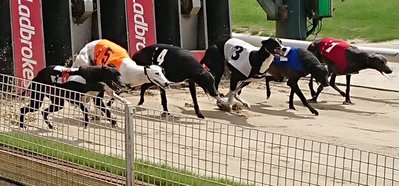Most Common Trifecta Numbers For Greyhounds
- So the trifecta pool remains largely untouched and that's why they pay so well. I believe it is the type of bet that has the largest number of losers per race. And that's great news for us since we get to enjoy nice beefy trifecta payouts week after week.
- The Trifecta or Tricast is a wager laid in horse racing meant to pick the first, second, and third in the exact order they’ve finished the race. The Trifecta is one of the most popular exotic wager available in horse racing and so the use of a trifecta calculator, which is a horse racing calculator, is very common among punters. The Trifecta wager is available in three different variations.
By: Amy Wolfgang, DVM

Most Common Trifecta Numbers For Greyhounds Breeders
In other words, a “12/1234/12345” wager would be your highest ranked two dogs in the WIN position, your top four dogs in the PLACE position, and your top five dogs in SHOW. Your actual dog number wager might be such as: 24/1246/12468. It is simple enough to compute the cost of various types of TRIFECTA. To cut down the number of tickets and their cost, many greyhound racing bettors choose the best dogs out of eight and box them into quiniela. They’ll pick 4 most promising dogs, then the total number of tickets necessary to cover all possible combinations of two.

Just as people face certain ailments as they age, so do our beloved Greyhounds. This is something that unfortunately we face much sooner with our dogs since they age about seven times faster than humans. To put this in perspective, a ten year old Greyhound is equivalent in years to a seventy year old person. Greyhounds age particularly fast due to their large body size, poor nutrition and sanitation during their formative years at the track, and from the extreme exertion placed on their bodies from years of racing. Therefore, a Greyhound is considered to be a “senior citizen” by approximately seven or eight years of age. The following is a description of some common problems encountered in senior Greyhounds, including diseases, available treatments, and measures that can be taken for early for screening and prevention of disease.
One of the most common problems faced by aging Greyhounds is arthritis which is caused by a breakdown of cartilage in their joints. Cartilage functions as a cushion between the bones, so when the cushion is destroyed, the bones rub against each other which leads to inflammation and pain. The cartilage can be destroyed from normal weight bearing over time, from injury to the joints, or from malformation of joints due to poor breeding. Any dog can develop arthritis, but Greyhounds are at a higher risk as they are large breed dogs that have most likely sustained racing injuries and have been bred irresponsibly. Symptoms of arthritis include stiffness when walking, difficulty rising, reluctance to jump or climb stairs, and crying during movements. While some degree of arthritis will be expected, the severity and pain can be reduced with care at home and from your veterinarian. Keeping your dog at a lean body weight is important since excess body fat can place additional stress on the joints. Senior pets should be fed an appropriate amount of a good quality pet food as determined by your vet, and should not be fed table food or treats that are high in calories. Slow, controlled exercise, such as 15-20 minute leash walks 2-3 times per day, is important in maintaining a healthy body weight as well as keeping joints the joints lubricated and preventing stiffness. Finally, there are medications that can help prevent and alleviate the pain of arthritis. Greyhounds of any age can take a daily joint supplement containing Glucosamine/Chondroitin Sulfate to decrease the severity of this disease. This supplement can be found at most pet stores and veterinary clinics and is also found as an ingredient in some of the commercial pet foods. It works by helping to repair and restore the damaged cartilage within the joints and does not require a prescription. Prescription medications that decrease inflammation and pain associated with arthritis such as Rimadyl or Deramaxx are also available to help keep your pet comfortable. Your veterinarian will decide when these are appropriate and may require periodic bloodwork to monitor for side effects if your dog needs to take this type of medication on a daily basis. Arthritis can be a painful but manageable disease if detected and treated early and consistently.
Cancer is another common ailment faced by the aging Greyhound, particularly bone cancer. Osteosarcoma is the most common type of bone cancer in Greyhounds and usually occurs in carpus (wrist), shoulder, or stifle (knee). Symptoms of bone cancer can look very similar to those of arthritis. Therefore, it is imperative that you take your Greyhound to the vet if you notice any signs of limping or pain as these two diseases can only be distinguished via x-rays of the joints and bones. Bone cancer is extremely painful and aggressive. If not diagnosed early, it can spread to other areas of the body making prognosis for survival very poor. If diagnosed early, aggressive treatment is necessary to prevent spread of the disease and pain for the dog. Ideally, the affected limb must be amputated to alleviate the source of the cancer and the painful area of bone, followed by chemotherapy to destroy any cancerous cells that may have escaped into the bloodstream. Some dogs do very well with this type of treatment and do not experience the side effects from chemotherapy such as hair loss like in humans. However, not all dogs are good candidates for these procedures and this will be a very personal decision between you and your veterinarian if your Greyhound is diagnosed with this disease. Other types of cancer can also occur in Greyhounds, so alert your vet at the first signs of illness, and schedule your senior pet with him/her for regular checkups and routine lab tests at least twice a year.

Finally, senior Greyhounds can suffer from failure of one of more of their organs such as heart, kidney, or liver. Some Greyhounds are born with or develop a heart murmur (abnormal flow of blood through the heart). A heart murmur can be detected by your veterinarian when listening to your dog’s heart with their stethoscope. Murmurs can eventually lead to an accumulation of fluid in the lungs, known as heart failure. Symptoms of heart disease include coughing, difficulty breathing, weakness, or lethargy. If your dog has a murmur or any of these signs, your vet can do chest x-rays or an ultrasound of the heart to determine the cause and severity of the disease. There are many different heart medications and low sodium diets available to help prevent and treat heart disease if this should become necessary. The easiest way to prevent heart disease is by testing your Greyhound for heartworm disease annually and keeping them on monthly heartworm prevention. Liver or kidney failure can cause your Greyhound to exhibit symptoms such as vomiting, poor appetite, increased drinking or urinating, weight loss, or jaundice. If detected early through routine blood screens, these diseases can be managed with special diets and medications as prescribed by your vet. Yearly dental cleanings and home dental care can help
prevent some types of organ diseases by minimizing spread of bacteria from the mouth into the bloodstream. Good quality food and vitamins as recommended by your vet can also keep organs healthy and functioning well.
Greyhound Trifecta Strategy

Most Common Greyhound Trifecta
While we cannot keep our Greyhounds from aging, we can help them to lead a quality life well into their senior years. Make sure to have your senior Greyhound examined at least every 6 months by your vet, including routine lab tests to screen for disease. Monitor your Greyhound closely for any changes in behavior or health and report changes immediately to your vet. Most diseases can be managed or treated more successfully if diagnosed early. As in human health care, eating healthy, exercising, and regular preventive care can increase longevity and quality of life in our Pets as well!